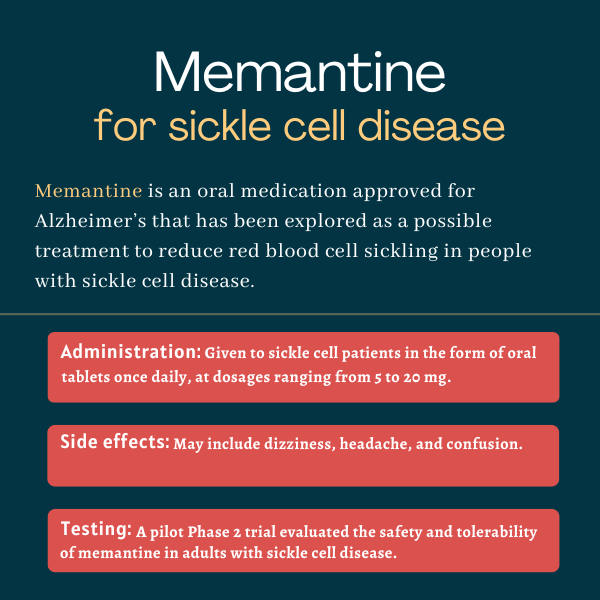Memantine for sickle cell disease
Last updated Aug. 8, 2024, by Marisa Wexler, MS

What is memantine for sickle cell disease?
Memantine is an oral medication that’s approved to treat moderate to severe dementia in people with Alzheimer’s disease. It’s also been explored as a possible treatment to help reduce red blood cell sickling in people with sickle cell disease (SCD).
Brand names and formulations
Memantine is sold under the brand names Namenda and Namenda XR, both of which are approved in the U.S. to treat moderate to severe dementia in people with Alzheimer’s disease. Namenda was approved by the U.S. Food and Drug Administration (FDA) in October 2003 and Namenda XR in June 2010. Both are marketed by Abbvie. Generic versions of memantine are also available.
Memantine is also sold with donepezil in a combined medication that’s marketed in the U.S. under the brand name Namzaric by Abbvie, and generic versions are also available. Like Namenda and Namenda XR, Namzaric is indicated for treating moderate to severe dementia in Alzheimer’s. It was approved by the FDA in December 2014.
Therapy snapshot
| Treatment name: | Memantine |
| Administration: | Oral tablets and extended-release capsules |
| Clinical testing: | A Phase 2 pilot study evaluating the safety of memantine in sickle cell patients has been completed |
How does memantine work in sickle cell disease?
SCD is a disorder that affects red blood cells, which are responsible for carrying oxygen through the bloodstream. In SCD, genetic mutations lead to an abnormal form of hemoglobin, the protein these cells use to carry oxygen, being produced. As a consequence, red blood cells become deformed and take on the “sickle” shape that characterizes the disease. The deformed red blood cells are prone to being destroyed prematurely and obstructing blood vessels, thereby driving SCD symptoms.
Memantine blocks the activity of N-methyl D-aspartate receptors (NMDARs), which are proteins that help cells detect certain signaling molecules. Several types of cells contain NMDARs. In the brain, nerve cells use NMDARs to communicate with each other. The overstimulation of NMDARs in the brain by a signaling molecule called glutamate is thought to be involved in the mechanisms that drive Alzheimer’s disease, which is the reason why targeting these receptors can be beneficial in people with dementia.
Red blood cells also contain NMDARs, which help them regulate the uptake of calcium ions.
Research has shown that, in people with SCD, red blood cells tend to have substantially higher levels of NMDARs. The higher than normal NMDAR levels means red blood cells of SCD patients are prone to take up higher amounts of calcium, which can lead to dehydration and worsen sickling. By blocking the activity of NMDARs in red blood cells, it’s thought that memantine may help keep cells hydrated to reduce sickling, thereby preventing SCD symptoms.
How is memantine administered in sickle cell disease?
Memantine is an oral therapy that’s supplied in the form of:
- standard film-coated tablets (sold as Namenda) that are available in dosage strengths of 5 and 10 mg
- extended-release capsules (sold as Namenda XR) that are available in dose strengths of 7, 14, 21, and 28 mg.
In its approved indication, the recommended starting dose for memantine is 5 mg per day (standard tablets) or 7 mg per day (extended-release capsules). The dose can then be increased by 5 mg or by 7 mg, up to a maintenance dose of 10 mg twice daily or 28 mg once daily, respectively. Lower doses are recommended for patients with kidney function impairment.
Since memantine is not approved for SCD, there are no standard guidelines for its dosing in people with the condition. In a pilot Phase 2 trial that tested memantine in SCD patients, participants were started on tablets at 5 mg per day, which was increased up to a maintenance dose of 20 mg per day.
Memantine in sickle cell disease clinical trials
A pilot Phase 2 clinical trial called MEMSID (NCT02615847) evaluated the safety of memantine in adults with SCD. The study enrolled six participants, all of whom were planned to take memantine at 5 to 20 mg for a year.
Two participants quit the study early due to side effects. One accidentally took an excessive amount of the medication, resulting in psychosis, and another experienced dizziness and vertigo that led to treatment being discontinued.
The other four participants were treated for a full year. Safety data showed the therapy was generally well tolerated. The only serious side effect was the instance of psychosis triggered by the suspected overdose. All side effects were temporary and manageable, with the most common being dizziness and/or vertigo.
Three of the four patients who completed the study reported improvements in life quality over a year on memantine. The one exception had severe infections related to travel that required repeated hospitalizations and negatively impacted that person’s life quality.
Analyses of patients’ red blood cells also indicated that treatment with memantine led to long-term changes, including a decrease in sickling.

Common side effects of memantine
Since memantine hasn’t been rigorously studied in SCD, its specific safety profile in people with the disorder is not known. In its approved indications, common side effects of memantine may include:
- dizziness
- headache
- confusion
- constipation
- diarrhea.
Changes in urine pH
The therapy’s prescribing information notes that conditions that raise the pH of the urine, causing it to be more alkaline, may reduce the excretion (elimination) of memantine, resulting in elevated levels of the medication in the body, and potentially adverse side effects.
Use in pregnancy and breastfeeding
There are no adequate data on the use of memantine in women who are pregnant or breastfeeding. In animal studies, using memantine during pregnancy resulted in developmental problems for the fetus when it was given at doses higher than those used in people, but not at doses equivalent to those typically administered clinically. The potential benefits and risks should be considered when deciding whether to use memantine in these situations.
Sickle Cell Disease News is strictly a news and information website about the disease. It does not provide medical advice, diagnosis, or treatment. This content is not intended to be a substitute for professional medical advice, diagnosis, or treatment. Always seek the advice of your physician or other qualified health provider with any questions you may have regarding a medical condition. Never disregard professional medical advice or delay in seeking it because of something you have read on this website.
Recent Posts
- Reflecting on 4 years of sharing my experiences with sickle cell
- Level of physical activity tied to less pain, blood viscosity in SCD: Study
- Celebrating ourselves is a way to promote sickle cell awareness
- BEAM-101 shows sustained benefits as treatment for sickle cell
- Attending a hematology conference as a sickle cell patient is empowering
- World Sickle Cell Day events include walks, vigils, building lights
- This World Sickle Cell Day, I’m grateful for UK advocacy groups
- Sickle cell disease cell therapy named FDA orphan drug
- Silence of sickle cell in children doesn’t always indicate mild disease
- I can’t always identify the causes of a sickle cell crisis, despite my efforts
Related articles






